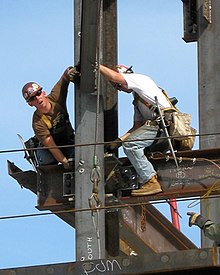Ironworker
**History of Ironworking:**
– Transition of carpenters to ironworkers in the 1880s.
– Use of cranes in construction in the early 1900s.
– Formation of the International Union of Ironworkers in the late 19th century.
– Fluctuation of ironworker wages over the years.
– Historical prominence of Mohawk tribesmen in ironworking in NYC.
**Types of Ironworkers:**
– Reinforcing Ironworkers: Work with reinforcing bars, tying them together with tie wire and placing rebar inside forms. Use tools like pliers, tie wire reels, and rebar hooks.
– Structural Ironworkers: Assemble cranes, lift steel columns, beams, and girders according to blueprints, and work on various structures like buildings and bridges.
– Ornamental Ironworkers: Fabricate and erect structural steel frameworks, work on various structures like stadiums and hospitals, and use materials such as metals, plastics, and composites.
**Tasks of Structural Ironworkers:**
– Use taglines to control beams.
– Hoist steel into place with cranes.
– Position beams with spud wrenches.
– Bolt beams to steel columns.
– Erect joist girders, bar joists, trusses, and metal decking.
**Tools of Structural Ironworkers:**
– Spud wrench, bolt bag, sleever bars.
– Bull pins, drift pins, beaters.
– Spud wrench serves dual purposes.
– Bolt bag stores bolts and nuts.
– Drift pins align holes made up of multiple plates.
**Safety in Ironworking:**
– Fall harnesses reduce fatalities.
– Ironworking is one of the most dangerous construction occupations.
– Approximately 38 fatalities per 100,000 ironworkers annually.
– Constant safety precautions are necessary.
– Importance of safety training and equipment.
An ironworker is a tradesman who works in the iron-working industry. Ironworkers assemble the structural framework in accordance with engineered drawings and install the metal support pieces for new buildings. They also repair and renovate old structures using reinforced concrete and steel. Ironworkers may work on factories, steel mills, and utility plants.
 Building a bridge like this is a common ironworker job. | |
| Occupation | |
|---|---|
Occupation type | Vocational |
Activity sectors | Construction |
| Description | |
| Competencies | Heights, patience, steady hand, ability to read plans, physically strong |
Education required | Apprenticeship |
Fields of employment | Construction |
Related jobs | Carpenter, Electrician, Plumber, Welder |

A structural/ornamental ironworker fabricates and erects (or even dismantles) the structural steel framework of pre-engineered metal buildings, single and multi-story buildings, stadiums, arenas, hospitals, towers, wind turbines, and bridges. Ironworkers also unload, place and tie reinforcing steel bars, (rebar) as well as install post-tensioning systems, both of which give strength to the concrete used in piers, footings, slabs, buildings, and bridges. Ironworkers load, unload, place, and set machinery and equipment as well as operate power hoists, forklifts, and aerial lifts. They unload, place, and fasten metal decking, safety netting, and edge rails to facilitate safe working practices. Ironworkers finish buildings by erecting curtain wall and window wall systems, stairs and handrails, metal doors, and sheeting and elevator fronts. Ironworkers perform all types of industrial maintenance as well.
Historically ironworkers mainly worked with wrought iron or cast iron, but today they utilize many different materials including ferrous and non-ferrous metals, plastics, glass, concrete, and composites.
An ironworker is distinct from a blacksmith, which is someone who works with, shapes, and tempers raw iron.
